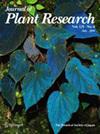木本植物扦插繁殖过程中激素在不定根形成中的作用。
IF 2.3
3区 生物学
Q2 PLANT SCIENCES
引用次数: 0
摘要
扦插诱导不定根的形成是无性繁殖的关键,是产生与亲本相同植株的关键途径。然而,由于AR形成困难,许多木本植物对无性繁殖提出了挑战。激素在AR形成过程中发挥重要作用,生长素是关键的调节因子,并与其他激素相互作用。本文就木本植物AR形成的分子事件及激素功能进行综述。对这些过程的深入了解可以提高木本植物无性繁殖技术的设计和操作,最终带来更大的经济效益。本文章由计算机程序翻译,如有差异,请以英文原文为准。
Hormone functions in adventitious root formation during cutting propagation of woody plants.
Cutting-induced adventitious root (AR) formation is crucial for vegetative propagation, a key method that produces plants identical to parent. However, many woody plants pose challenges for vegetative propagation due to difficulties in AR formation. Hormones play important roles during AR formation, with auxin serving as the key regulator and interacting with other hormones. In this review, we summarize the molecular events and hormone functions involved in AR formation in woody plants. A deeper understanding of these processes could enhance the design and manipulation of techniques to improve vegetative propagation in woody plants, ultimately leading to greater economic benefits.
求助全文
通过发布文献求助,成功后即可免费获取论文全文。
去求助
来源期刊

Journal of Plant Research
生物-植物科学
CiteScore
5.40
自引率
3.60%
发文量
59
审稿时长
1 months
期刊介绍:
The Journal of Plant Research is an international publication that gathers and disseminates fundamental knowledge in all areas of plant sciences. Coverage extends to every corner of the field, including such topics as evolutionary biology, phylogeography, phylogeny, taxonomy, genetics, ecology, morphology, physiology, developmental biology, cell biology, molecular biology, biochemistry, biophysics, bioinformatics, and systems biology.
The journal presents full-length research articles that describe original and fundamental findings of significance that contribute to understanding of plants, as well as shorter communications reporting significant new findings, technical notes on new methodology, and invited review articles.
 求助内容:
求助内容: 应助结果提醒方式:
应助结果提醒方式:


